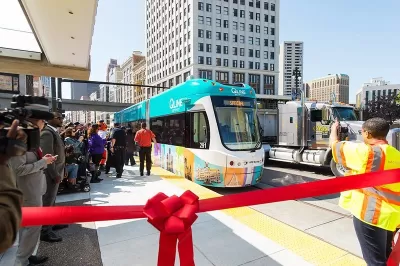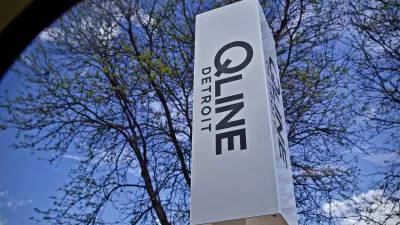The QLine could ride its own dedicated lane and serve a real need for commuters. Instead, it's a slow circulator for a small part of downtown.

Detroit's QLine was originally pitched as an attraction that would raise the value of the land around it, so those who owned that land ended up having an outsized say in its development. It was to be paid for by land owners around the route, "but they soon decided not to cover all the costs, and enlisted government support," Angie Schmitt reports for Streetsblog USA. The QLine eventually received $37 million in capital funds from U.S. DOT and another $10 million from the state of Michigan."
Despite the funding, the streetcar kept a small route a short 3.3-mile route that few have been willing to pay to ride. "It simply doesn’t serve that many people. Ridership dropped about 40 percent, to 3,000 trips per day, after the streetcar started charging a $1.50 fare in August," Angie Schmitt writes. Because it's running on a side alignment in traffic, the streetcar runs fairly slowly and can be blocked by traffic. "Public comments overwhelmingly favored the center-running approach, but 'Gilbert in particular pushed for side alignment,' according to the report, which he again believed would be better for economic development," Schmitt writes.
FULL STORY: How Detroit’s Streetcar Overlooked Real Transit Needs to Satisfy a Well-Connected Few

Planetizen Federal Action Tracker
A weekly monitor of how Trump’s orders and actions are impacting planners and planning in America.

San Francisco's School District Spent $105M To Build Affordable Housing for Teachers — And That's Just the Beginning
SFUSD joins a growing list of school districts using their land holdings to address housing affordability challenges faced by their own employees.

The Tiny, Adorable $7,000 Car Turning Japan Onto EVs
The single seat Mibot charges from a regular plug as quickly as an iPad, and is about half the price of an average EV.

With Protected Lanes, 460% More People Commute by Bike
For those needing more ammo, more data proving what we already knew is here.

In More Metros Than You’d Think, Suburbs are Now More Expensive Than the City
If you're moving to the burbs to save on square footage, data shows you should think again.

The States Losing Rural Delivery Rooms at an Alarming Pace
In some states, as few as 9% of rural hospitals still deliver babies. As a result, rising pre-term births, no adequate pre-term care and "harrowing" close calls are a growing reality.
Urban Design for Planners 1: Software Tools
This six-course series explores essential urban design concepts using open source software and equips planners with the tools they need to participate fully in the urban design process.
Planning for Universal Design
Learn the tools for implementing Universal Design in planning regulations.
Smith Gee Studio
City of Charlotte
City of Camden Redevelopment Agency
City of Astoria
Transportation Research & Education Center (TREC) at Portland State University
US High Speed Rail Association
City of Camden Redevelopment Agency
Municipality of Princeton (NJ)




























